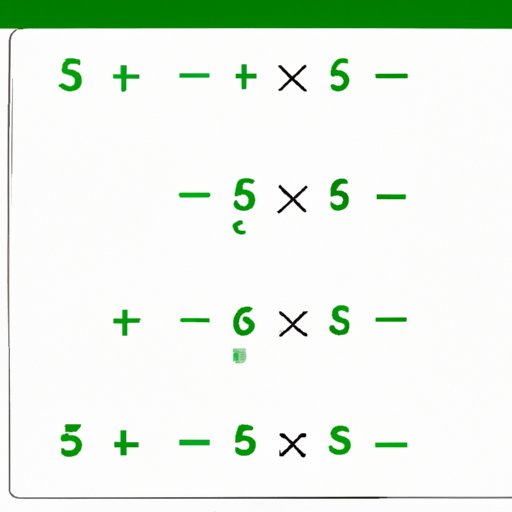
Introduction
When dealing with math problems, simplifying fractions is a basic skill people need to learn. Simply put, simplifying fractions involves reducing them to their smallest possible form. This means finding a way to divide both the numerator and denominator of a fraction by a common factor, making the overall fraction smaller but still equivalent in value. This article aims to provide a comprehensive guide on how to simplify fractions and why it is an essential math skill to acquire.
A Step-by-Step Guide to Simplifying Fractions
To simplify fractions, you need to understand the concept of finding the greatest common factor of the numerator and denominator. Here are the steps to follow:
- Step 1: Find the greatest common factor (GCF) of the numerator and denominator.
- Step 2: Divide both the numerator and denominator by the GCF.
- Step 3: Continue simplifying the fractions until you cannot divide them any further.
For example, let us consider the fraction 24/36. To simplify this fraction, we need to find the GCF of 24 and 36. In this case, the GCF is 12. Dividing both the numerator and denominator by 12, we have 2/3. As 2 and 3 do not have any common factors other than 1, we can conclude that 2/3 is the simplest form of the original fraction.
The Importance of Simplifying Fractions in Basic Arithmetic
Simplifying fractions is a crucial skill when dealing with basic arithmetic operations such as addition, subtraction, multiplication, and division. Simplified fractions make it easier and faster to perform these operations as the numbers involved are smaller and easier to work with.
For example, imagine adding 2/3 to 3/4 without simplifying the fractions first. The common denominator of both fractions is 12. Thus, we have
2/3 = 8/12
3/4 = 9/12
Adding these fractions, we have
(8/12) + (9/12) = 17/12
This fraction can be simplified by dividing both the numerator and denominator by its GCF, 1. We have 17/12 as the resulting fraction, which is not in its simplest form. However, by simplifying the fraction first, we can perform the operation much faster.
Common Mistakes to Avoid When Simplifying Fractions
One common mistake people make when simplifying fractions is forgetting to divide both the numerator and denominator by the same number. This results in an incorrect, unsimplified fraction. Another mistake is simplifying the fraction too much, resulting in an incorrect answer.
To avoid these mistakes, always ensure that you divide both the numerator and denominator by the same factor. Additionally, continue simplifying the fraction until you cannot divide it any further. This ensures that you get the simplest fraction possible.
Ways to Simplify Mixed Numbers with Ease
A mixed number is a combination of a whole number and a proper fraction. To simplify mixed numbers, you need to first convert them to improper fractions and then simplify them using the same steps as regular fractions. You can do this by multiplying the whole number by the denominator of the fraction and adding the numerator. The result becomes the new numerator, and the denominator remains the same.
For example, let us consider the mixed number 2 1/4. To convert this to an improper fraction, we multiply the whole number, 2, by the denominator, 4, and add the numerator, 1. The resulting numerator is 9, and the denominator remains 4. Thus, 2 1/4 as an improper fraction is 9/4. We can then simplify this fraction as explained previously.
Explaining the Concept of Greatest Common Factor in Simplifying Fractions
The GCF is the largest number that divides evenly into both the numerator and denominator of a fraction. To simplify fractions, we divide both the numerator and denominator by their GCF. This ensures that we reduce the fraction to its smallest possible form while still retaining its value. For example, consider the fraction 16/20. The GCF of 16 and 20 is 4. Dividing both the numerator and denominator by 4, we have 4/5, the simplest form of the fraction.
Visual Aids to Simplify Fractions
Visual aids such as number lines, diagrams, and pictures can help people understand how to simplify fractions. Using a number line, for example, can help visualize dividing a fraction into smaller parts. Diagrams and pictures can also represent fractional parts, making it easier to grasp the concept of simplification.
Practical Applications of Simplifying Fractions in Real-Life Situations
Simplifying fractions is not only a math skill but also a useful tool in everyday life. Cooking, for example, involves measuring ingredients using fractions. Simplifying fractions makes it easier to calculate measurements and adjust recipes according to serving size. Additionally, understanding how to simplify fractions is crucial for budgeting and financial planning where understanding interest rates and percentages is important.
Conclusion
In conclusion, simplifying fractions is a fundamental math skill that has practical applications beyond the classroom. Understanding the concept of GCF and how to simplify fractions is crucial in performing basic arithmetic operations. By following the step-by-step guide and avoiding common mistakes, anyone can learn to simplify fractions with ease. Visual aids can also help make the concept more accessible, and real-life situations demonstrate the practical applications of this skill.
Practice is the key, and additional resources such as online tutorials and textbooks can help you enhance your skills. Simplifying fractions may seem challenging at first, but with practice and dedication, you can master it.





